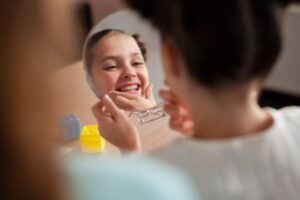
OT Strategies to Support Self-Care in Children with Autism
Self-care (also called “activities of daily living” or ADLs) includes tasks like dressing, feeding, toileting, hygiene (brushing teeth, bathing), grooming, and more. For children with autism, building self-care skills can be a pathway toward greater independence, confidence, and quality of life. Occupational therapy (OT) offers tools, structure, and individualized support to make those everyday tasks more doable and less stressful.
What Makes Self-Care Challenging for Children with Autism
Before talking strategies, it helps to recognize why self-care can be hard for some children with autism. The challenges aren’t about “not wanting” to do tasks—they often stem from:
- Sensory sensitivities: Some textures, smells, or sensations feel overwhelming (e.g. the feeling of socks, the sound of running water, the stiffness of certain clothing).
- Motor coordination issues: Fine motor skills (buttoning buttons, zippers, tying shoelaces), or gross motor components (balancing in bath, stepping into sink, lifting arms) may be harder. Difficulty with sequence and organization: Tasks like dressing or brushing teeth involve many steps; remembering and doing them in order, or knowing when to begin or end, can be tricky.
- Communication or comprehension differences: Understanding verbal instructions or abstract instructions (“After you finish brushing, rinse with water”) may be harder. Also, expressing which part of the task is uncomfortable may be difficult.
- Motivation, anxiety, or transition issues: Anxiety around the task (fear of mess, discomfort), or the stress of transitioning into or out of a self-care routine, can reduce participation.
How OT Helps: Key Strategies
OTs bring a thoughtful, supportive framework to help children build self-care skills. Below are strategies that often prove effective—and examples for how they can be used.
- Task Analysis & Breaking Down Skills
- Break tasks into smaller steps: Instead of teaching “getting dressed,” OT may break that into putting on socks → pulling up pants → buttoning shirt → etc. This makes learning and mastering each part easier.
- Use chaining: Start by helping the child with most of the steps, gradually fading help one step at a time.
- Visual Schedules, Checklists, & Social Stories
- Visual step-by-step charts: Show pictures or symbols for each part of a self-care task (for example, toothbrushing: get toothbrush, wet, put toothpaste, brush, rinse, put away). Visual cues help with memory, sequencing, and reducing dependence on verbal prompting.
- Social stories / narrative scripts: Especially helpful for tasks that may be anxiety-provoking (hair cutting, dentist, etc.). Explaining “what happens first, then, last” helps reduce uncertainty.
- Sensory Supports & Adaptations
- Desensitization / gradual exposure: Introduce sensory challenging parts gradually (e.g. starting with wearing soft socks near arm, then lower leg, then foot). Allow child to explore textures at their own pace.
- Modify materials / tools: Use adaptive tools (e.g. button hooks, Velcro instead of buttons, pull-loops, easier fasteners) to reduce frustration.
- Create sensory-friendly environment: Use tolerable lighting, minimal noise, comfortable temperature, softer textures, etc. Provide sensory breaks.
- Motor Skill & Physical Work
- Fine motor practice: Working on finger strength (playdough, theraputty), grasp patterns, manipulation, hand-eye coordination (picking up small objects, fastening).
- Gross motor work / stability: Ensuring good posture while dressing (stable seating or standing support), coordinating movements (lifting arms, bending, stepping). Strength, balance, coordination all help reduce the physical effort of self-care tasks.
- Routine, Consistency & Practice
- Establish predictable routines: Doing self-care tasks at the same time, in the same order, with the same cues. Predictability helps children know what to expect and reduces resistance.
- Frequent, consistent practice: Repetition builds familiarity and confidence. Even small practice daily helps.
- Positive Reinforcement & Motivation
- Praise effort & small wins: Highlighting what the child can do and improvements (not just full mastery) helps build confidence.
- Use incentives / motivating rewards: These could be small — stickers, a preferred activity, social praise — tied to completion of tasks or steps.
- Environmental Adaptation & Caregiver Coaching
- Modify the environment: For example, organizing clothing so it’s easy to reach, using low hooks, non-slip mats, bench or stool where needed. Tools placed at appropriate heights.
- Coaching caregivers / teachers: Showing them how to cue, prompt, fade help; how to set up visuals; how to support sensory regulation. Consistency between home, school, OT sessions matters.
Putting It Into Practice: Sample OT Plan for Self-Care Skill Building
Here’s how an occupational therapist might structure a plan with a child and their caregiver(s) to build independence in self-care:
| Phase | What Happens | Example Goal |
| Assessment & Goal Setting | OT evaluates sensory profile, motor ability, preferred tools / motivators; identifies which self-care tasks are priorities. | “Be able to unfasten Velcro shoes independently” or “Brush teeth with supervision every morning.” |
| Design the Steps & Supports | Break down the task; create visual schedule; choose adaptive tools; plan sensory supports. | Create a 5-step visual chart for tooth brushing; test different toothbrush textures to find comfortable one. |
| Introduce & Practice | Practice with full support, use prompts, allow time, provide feedback; use reinforcement. | OT and caregiver guide child through brushing with prompts, then fade prompts over time. |
| Generalize & Expand | Try the task in different locations/settings (school, home, grandparents’ house); vary tools or routines gradually. | Practice dressing in preschool, then at home, then on weekends; try different outfits to build flexibility. |
| Review & Adjust | Ongoing evaluation of what works, what is hard; adjust materials, routine, steps; maybe lower/higher expectations as skills improve. | If buttons are still hard, move to bigger buttons or Velcro, or practice buttoning only one side first. |
Tips & Considerations
- Be patient: mastering self-care skills often takes time, with progress in small steps rather than big leaps.
- Respect the child’s sensory preferences and tolerances; pushing through too much discomfort can backfire.
- Use child’s interests and motivation — for example, let the child pick their own toothbrush or favorite soap.
- Ensure consistency across environments (home, school, OT) so that supports don’t conflict.
- Celebrate successes—no matter how small. Each small step toward independence is meaningful.
Conclusion
Self-care skills are essential building blocks for independence and self-esteem in children with autism. Occupational therapy supports children by offering tailored strategies to address sensory, motor, communication, and behavioral challenges. By breaking tasks into manageable steps, utilizing visuals and routines, adapting the environment, and encouraging practice in natural settings, OT helps children with autism become more capable and confident in daily life. With time, patience, and the right supports, self-care can shift from being a struggle to a strength.
